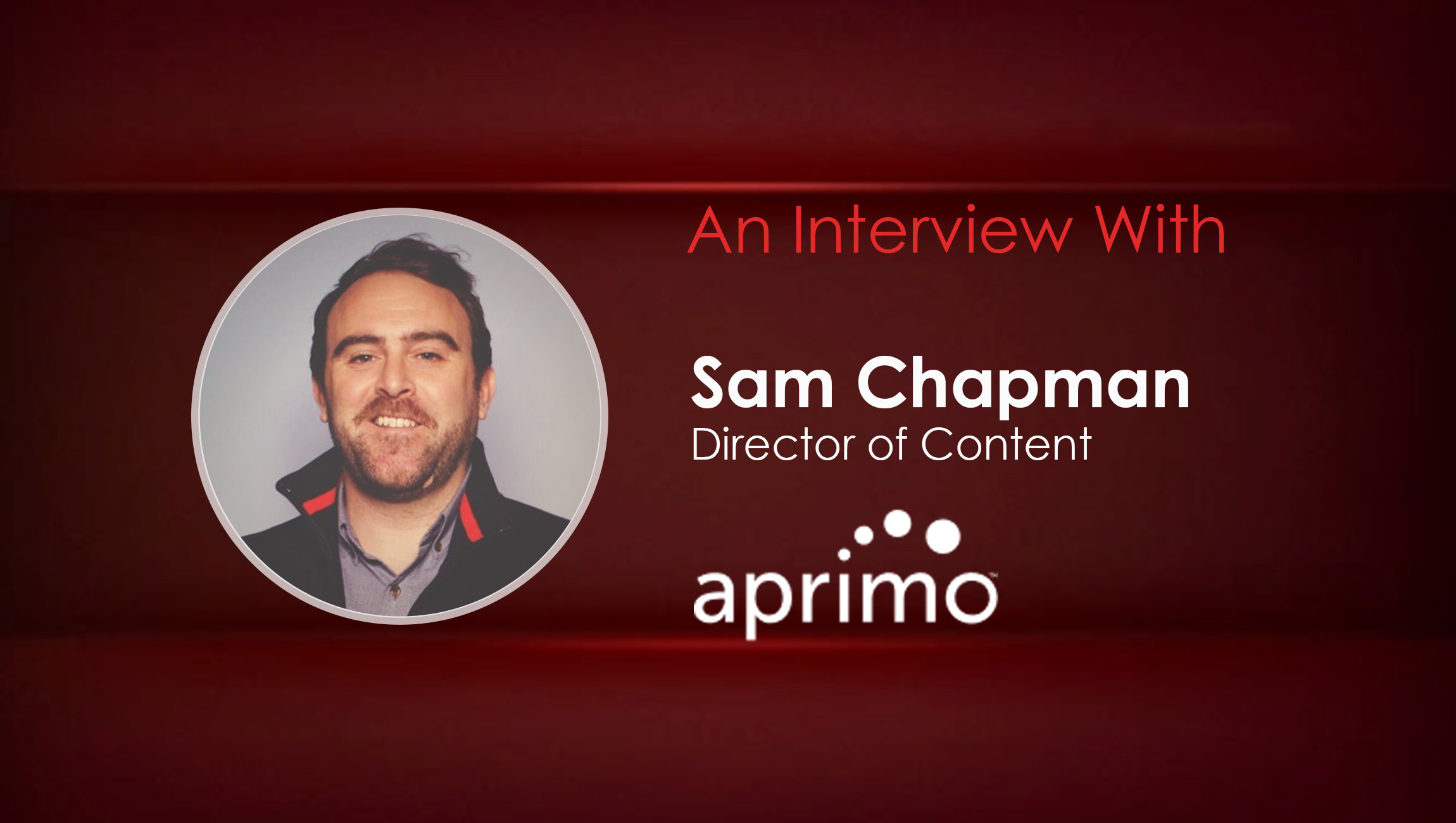Sam Chapman, Director of Content Strategy and Brand Experience at Aprimo chats about the evolution of B2B content marketing and how DAM platforms can benefit content teams:
_________
Welcome to this MarTech Series chat Sam, tell us about yourself and what inspires you about content marketing today?
It’s probably not as true as it used to be, but what I love about content marketing—and to an extent, marketing in general—is that most people seem to have found their way into it. My background is in the written word—journalism, travel writing, research, blogging for think tanks, political communications, etc. My first job as a content writer was a mashup of PR, copywriting, blogging, market research, and product marketing.
I’m incredibly fortunate to have been in this game since it emerged. I’ll call it the proto-content era, where most people had a very vague idea of what it did and what it was for. So a “content writer/strategist/marketer” meant a multitude of things, and in many ways it still can. This is actually a great way to understand whether a company prioritizes content as a strategic part of the business. Do they have a clearly defined role and understanding of the importance of content, or are they looking for a swiss army knife that’s really a mashup of four jobs under the guise of one?
What’s inspiring to me is that I’m seeing the role of content evolve as a critical part of the business, which means there are more marketing leaders that have come up this way and are the ones who are driving change. If you think about it, content marketers are the perfect change agents because what we’ve done has always been somewhat non-traditional in terms of the art and science of marketing. But at the same time, I still see so many content people—whether they are called writers, strategists, or marketers doesn’t matter—getting sucked into writing emails and blogs, ghostwriting, drafting scripts, social posts, and on and on to where your tools of the trade are commoditized and you’re just cranking it out like you work at a deli counter rather than meaningfully contributing to the business.
Marketing Technology News: What is a Content Marketing Matrix?
We’d love to hear your thoughts on the importance and Future of DAM in B2B…
While DAM isn’t new—in fact, it’s been around for decades—it’s integral to an enterprise’s digital experience tech stack. It’s often spoken about in the same circle as digital experience platforms (DXP) and content management systems (CMS). But where DAM sets itself apart is that it’s the backbone to delivering personalized experiences at scale. DAM’s resurgence is very much a reflection of the world around us. The sheer volume of content, call it big content, has led to management chaos—not only of the creation, collaboration, and production of content, but the governance of a content experience’s individual components and all its forms. Content chaos is marketing chaos, and marketing chaos is a symptom of a business in disarray. It is very much a reflection of your corporate strategy in that if you don’t have a system in place to support your content strategy to deliver excellent experiences at scale, then you’re doing it wrong.
The recent Forrester Wave for Digital Asset Management reports that 50% of the customer references surveyed have been using their DAM for two years or less. But increasingly, DAM is seen as a strategic part of an enterprise’s technology and content initiatives. 44% reported that it is core to their stack, deployed across the enterprise, and heavily integrated into adjacent digital experience systems, while 46% stated that it’s important to their business, but they haven’t integrated DAM as well as they could have and have not deployed it broadly. There’s a lot of room for opportunity in those numbers.
Marketing Technology News: Powering Your Marketing With Video Ads and Video (Social Media) Posts
The thing about DAM is its potential. At first glance or at its most basic utility, it’s not very sexy. But when you start unpacking it from an architectural point of view, from the potential to build a robust tech ecosystem through APIs and connectors to the way you set up its governance, its metadata, and taxonomy, you give it a personality and breathe life into it. Inherent flexibility is essential to selecting a DAM: can it grow with you, can it accommodate all current and future states of content, will it be there in another decade, still laboring on? That’s another brilliant thing about DAM—it sits behind all the flashy martech, carrying the burden of doing the work in the background, asking for nothing but all the while streamlining, organizing, optimizing, and measuring the content your customers interact with.
When it comes to content marketing practices, what are some of the strategies you pursue strongly and some of the martech that helps achieve those outcomes? Of course, tools besides DAMs!
Content strategy is hard, if you’re going about it the right way. I like to think about it like this: content strategy is theory and practice, while content marketing is the game-day manifestation of that theory and practice. If you’re going to be a content kung-fu master, you need to know all the content meditations, content koans, and have practiced your katas over and over until you live and breathe them so during kumite you are like water. To use the Bruce Lee quote, “You put water into a cup, you become the cup, you put water into a bottle, you become the bottle.” In this way, you need to think of your audience as the potential vessel that you want to fill up with your ideas and information.
Another hard part, and this is often a lesson learned the hard way, is that you have to show your work. And by that I mean the data—both quantitative and quantitative—which, when combined, is an extension of the theory and practice. This is why I think those with backgrounds in the social sciences are well suited for content careers. They are comfortable aiming for a granular proof point, the statistical relevance, but understand that when human emotion is involved, a level of variance calls for qualitative signals to balance out how you execute and report on downstream performance. You need both—it’s more than the elusive content ROI that can take months after a campaign has wrapped to get to it. It’s also your team’s efforts and the activity happening around the numbers. Whether it’s customer interviews, unpacking chat logs and discovery calls, comments on social, Q&A during events, or thought leadership interviews, so much goes on in the qualitative that can’t be ignored.
Marketing Technology News: MarTech Interview with Jeffrey Ha, Chief Go-to-Market Officer at Rev
If you had to change a few things about content marketing in B2B, what would they be?
I’ve mentioned at least two of them: misunderstanding or misusing the role of a content strategist/marketer/writer and using that role as a catch-all for all your unfounded goals around blog post frequency, email, thought leadership, internal communications, branding, etc. In short, when the content person is somehow the only person in your organization that can write complete sentences and becomes a bottleneck by default.
The next is how often content still is not being seen as a strategic component of business success, which change one (mentioned above) stems from. It’s challenging because you’re up against institutional thinking. When content is an afterthought, you’re going to end up with uninspiring, competitor-generated copy-paste and that will be clear to your audience. Martech or SEO hacks aren’t going to do anything for you if your content doesn’t deliver. So that’s my third: Content in B2B needs to be approached with the same rigor as a product or service.
What can content marketers today do to stand out from the crowd? Can you throw light on some of the most exciting/inspired content marketing tactics you’ve seen in B2B off late?
Be honest, with yourself and with your audience. Intellectual honesty is so important in what we do. And do your homework. My advice for any content marketer—but especially for mid-level or above—is to make your first 90 days really about what you need to be successful. If you just jump in trying to please everyone from day one you’re going to end up in the catch-all role mentioned above. And this is perhaps something I didn’t mention, that you have control over it. It’s not just the organization, be vocal about the time you need to understand the business, its customers, how products and services work, and craft your strategy.
So while I can share some thoughts on the tech I use and might endorse, they won’t matter much without a rock-solid strategy that’s been peer-reviewed and has buy-in from stakeholders outside of your orbit.
There are a bunch of great tools out there: Ahrefs, SEMrush, Moz (depending on which SEO camp you’re in), Answer the Public, without naming any one in particular you absolutely need a highly capable productivity and project management tool, HotJar, Riverside, Descript, Figma, Linkhunter…the list goes on and on.
While I use or have used the tools above, in our day-to-day at Aprimo, we have architected a unique solution for delivering digital experiences. We of course use Aprimo to manage all our digital assets, as well as provide brand portals for our agencies and tech partners, but we also connect it straight to our CMS, which is powered by WordPress VIP. We can manage our modular content strategy in Aprimo, connect our approved brand assets directly to our CMS to publish on the website, and then further downstream, we also integrated Parse.ly for robust content analytics, which we can then combine with Aprimo’s Return on Effort feature to get a clear picture of the efforts we are putting into content creation and whether they are having an impact at the campaign level. That lets us know where we should spend our precious cycles and which kinds of content we focus on building.
Marketing Technology News: MarTech Interview with Ed Locher, Vice President of Marketing at HG Insights
We’d love to hear a few predictions you have in mind for the future of martech and B2B content marketing!
AI and machine learning are gaining ground in content marketing. And while there’s no substitute for human-powered strategy, some tools can give you ideas on where to spend your time for optimal conversions, what to create next, trimming down the time it takes to research keywords and select topics, as well as tracking performance. These tools can help with speed and scale, and also be a handy validation mechanism to go along with your gut instincts gleaned from your own research and ideal customer profile immersion.
Lastly, people and brands are going to dump a lot of dough into the metaverse, into NFTs, with some going all-in on it. Here’s the thing. It won’t last. Maybe the better word is endure. I guess my hot take here is that it’s a fad, not the future. I don’t think the same way about blockchain or cryptocurrency and its potential for positive social impact. Indeed, once some of the more pressing hurdles are addressed it might very well achieve its potential as an open and democratic technology. However, this rush to the metaverse and NFT markets is a corrupting trend in the long run that at least in my view devalues a lot of the positive things that gave velocity to this movement. Maybe this is just my dim optimism shining through, but there’s hope that it is a passing trend, and not the second iteration of an always-on overly socially engineered dystopian pressure cooker.

Aprimo provides technology solutions for content, operations, and performance that enable enterprises to optimize their brand experiences and the resources they use to deliver them.
Sam Chapman is the Director of Content Strategy and Brand Experience at Aprimo











